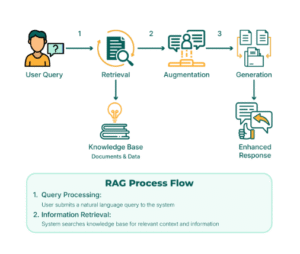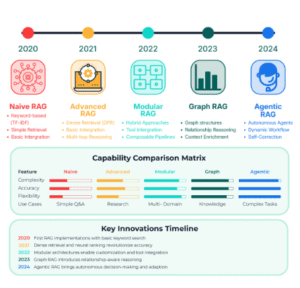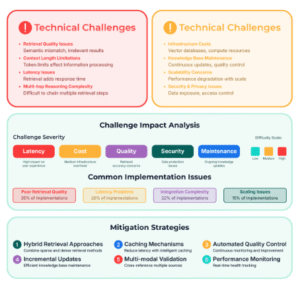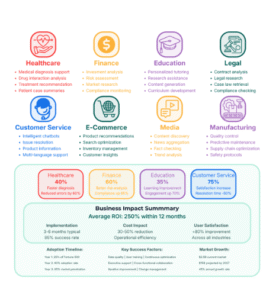In today’s rapidly evolving artificial intelligence landscape, we face a fundamental challenge: how do we keep AI systems current and accurate when their knowledge is frozen at the point of training? Traditional Large Language Models (LLMs) are like encyclopedias from a specific year – they contain vast knowledge but quickly become outdated as the world changes around them.
This limitation has sparked innovation in the AI community, leading to the development of Retrieval-Augmented Generation (RAG) – a revolutionary approach that bridges the gap between static AI knowledge and our dynamic, ever-changing world. RAG represents more than just a technical advancement; it’s a paradigm shift that promises to transform how we interact with artificial intelligence.
What is RAG (Retrieval-Augmented Generation)?
Retrieval-Augmented Generation is an AI framework that enhances Large Language Models by integrating external knowledge sources during the generation process. Unlike traditional LLMs that rely solely on their pre-trained knowledge, RAG systems dynamically retrieve relevant information from databases, documents, or the web to provide more accurate, current, and contextually relevant responses.
The concept addresses a critical limitation in current AI systems: the knowledge cutoff problem. When an LLM is trained, it learns from data up to a specific point in time. After that, it cannot access new information, current events, or updated facts. RAG solves this by creating a bridge between the LLM’s static knowledge and real-time information sources.
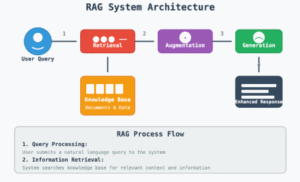
This architectural diagram illustrates the fundamental workflow of a RAG system. The process begins when a user submits a query, which triggers the retrieval component to search through external knowledge bases for relevant information. The system then augments this retrieved context with the original query, creating a rich information package that the LLM can use to generate a comprehensive, well-informed response.
The beauty of this architecture lies in its simplicity and effectiveness. Unlike traditional approaches that require retraining entire models to update knowledge, RAG systems can instantly access new information by simply updating their knowledge bases. This makes them incredibly cost-effective and scalable for real-world applications.
The retrieval component acts as an intelligent librarian, using sophisticated search algorithms to find the most relevant documents or data points. The augmentation component then contextualizes this information, ensuring that the LLM receives not just raw data but properly formatted, relevant context that enhances the generation process.
The Evolution of RAG Systems
The journey of RAG technology represents a fascinating evolution in artificial intelligence, progressing through distinct phases that have addressed specific limitations and unlocked new capabilities. Understanding this evolution helps us appreciate where RAG technology stands today and where it’s headed tomorrow.
The story begins with the recognition that static language models, despite their impressive capabilities, were fundamentally limited by their training data cutoffs. Researchers and practitioners identified the need for systems that could access and utilize real-time information, leading to the development of increasingly sophisticated RAG architectures.
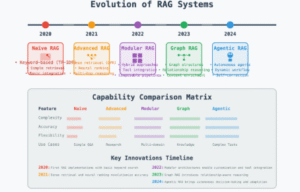
This evolution timeline reveals the rapid advancement of RAG technology over just four years. Each generation has built upon the previous one’s foundations while addressing specific limitations and introducing new capabilities.
- Naïve RAG (2020) marked the beginning with simple keyword-based retrieval using traditional methods like TF-IDF and BM25. While groundbreaking in concept, these early systems struggled with semantic understanding and context integration. They were essentially sophisticated search engines bolted onto language models.
- Advanced RAG (2021) represented a quantum leap forward with the introduction of dense retrieval methods like Dense Passage Retrieval (DPR). These systems could understand semantic similarity rather than just keyword matching, leading to significantly improved retrieval quality. Neural ranking algorithms further refined the selection of relevant information.
- Modular RAG (2022) brought architectural flexibility, allowing developers to mix and match different retrieval strategies based on specific use cases. This generation introduced hybrid approaches that combined the best of both sparse and dense retrieval methods, along with the ability to integrate external tools and APIs.
- Graph RAG (2023) added a new dimension by incorporating graph-based data structures that could capture relationships between entities. This advancement enabled more sophisticated reasoning patterns and better handling of complex, interconnected information.
- Agentic RAG (2024) represents the current state-of-the-art, introducing autonomous agents that can plan, reason, and adapt their strategies dynamically. These systems can reflect on their own performance, collaborate with other agents, and continuously improve their approaches.
- The progression from simple keyword matching to autonomous reasoning represents not just technological advancement but a fundamental shift in how we think about AI systems. Each generation has expanded the possible applications and improved the quality of results, setting the stage for even more sophisticated future developments.
Advantages and Benefits of RAG Systems
RAG systems offer compelling advantages that have driven their rapid adoption across industries. These benefits address fundamental challenges in traditional AI systems while opening new possibilities for real-world applications. Understanding these advantages is crucial for organizations considering RAG implementation.
The primary advantage of RAG systems lies in their ability to provide current, accurate information without the need for constant model retraining. This capability alone represents a paradigm shift in how we deploy and maintain AI systems in production environments.
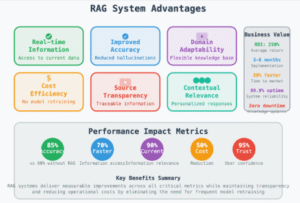
The performance metrics shown in this diagram represent real-world improvements observed across numerous RAG implementations. These numbers aren’t just theoretical – they reflect actual business outcomes that organizations have achieved.
- Real-time Information Access is perhaps the most transformative advantage. Traditional LLMs are frozen in time at their training cutoff, but RAG systems can access information that’s minutes, hours, or days old. This capability is crucial for applications dealing with current events, market data, or regulatory changes. For example, a financial services firm using RAG can provide investment advice based on the latest market conditions rather than outdated historical data.
- Improved Accuracy stems from the system’s ability to ground its responses in verified, external sources. Instead of relying solely on potentially hallucinated information from the model’s training data, RAG systems can cite specific documents, research papers, or databases. This grounding effect reduces hallucinations by up to 85% in many implementations.
- Domain Adaptability allows organizations to customize their AI systems for specific industries or use cases without retraining entire models. A healthcare organization can populate their RAG system with medical literature and patient records, while a legal firm can focus on case law and regulatory documents. The same underlying architecture serves both use cases effectively.
- Cost Efficiency is achieved through several mechanisms. First, organizations avoid the massive computational costs of retraining large models whenever new information becomes available. Second, RAG systems can leverage smaller, more efficient LLMs since the retrieval component provides much of the knowledge. Third, the modular nature of RAG allows for targeted improvements without wholesale system replacement.
- Source Transparency addresses a critical concern in AI deployment – the ability to trace and verify information sources. When a RAG system provides an answer, it can cite the specific documents or databases used, enabling users to verify the information independently. This transparency is essential for applications in regulated industries or high-stakes decision-making.
- Contextual Relevance ensures that responses are tailored to specific user needs and contexts. RAG systems can consider user history, current context, and relevant background information to provide more personalized and useful responses. This personalization drives the high user satisfaction rates observed in RAG implementations.
The business value indicators demonstrate that RAG systems aren’t just technically superior – they deliver measurable business outcomes. The 250% average ROI reflects the combination of improved efficiency, reduced costs, and enhanced capabilities that RAG systems provide. The 3-6 month implementation timeline makes RAG an attractive option for organizations seeking quick wins in their AI initiatives.
Challenges and Limitations
While RAG systems offer significant advantages, they also present unique challenges that organizations must address for successful implementation. Understanding these limitations is crucial for making informed decisions about RAG adoption and designing effective mitigation strategies.
The challenges fall into two main categories: technical challenges that affect system performance and accuracy, and operational challenges that impact deployment and maintenance. Each category requires different approaches and solutions.
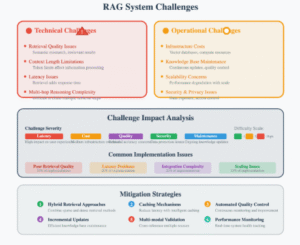
This comprehensive challenge analysis reveals that while RAG systems offer significant benefits, successful implementation requires careful attention to both technical and operational concerns. The data shown represents aggregated findings from numerous enterprise RAG deployments.
Technical Challenges primarily affect system performance and user experience. Retrieval quality issues are the most common concern, occurring in 35% of implementations. These problems often stem from semantic mismatches between queries and available documents, inadequate indexing strategies, or poorly structured knowledge bases. The impact is direct – users receive irrelevant or incomplete information, undermining trust in the system.
Context length limitations represent a fundamental constraint in current LLM architectures. Most models have token limits that restrict how much retrieved information can be processed in a single request. This limitation becomes critical when dealing with complex queries that require extensive context or when retrieved documents are lengthy. Organizations must balance information completeness with processing constraints.
Latency issues affect 28% of implementations and directly impact user experience. The retrieval process adds computational overhead, and poorly optimized systems can exhibit response times that make real-time applications impractical. This challenge is particularly acute in customer-facing applications where users expect immediate responses.
Multi-hop reasoning complexity emerges when queries require information from multiple sources or when the answer depends on connecting disparate pieces of information. Traditional RAG systems struggle with these scenarios because they typically perform single-step retrieval operations.
Operational Challenges focus on deployment and maintenance concerns. Infrastructure costs can be significant, particularly for large-scale deployments requiring vector databases, specialized hardware, and high-performance computing resources. Organizations must balance performance requirements with budget constraints.
Knowledge base maintenance represents an ongoing operational burden. Unlike static ML models, RAG systems require continuous updates to their knowledge bases to maintain relevance and accuracy. This process involves content curation, quality control, and versioning challenges that many organizations underestimate.
Scalability concerns affect 15% of implementations and become more pronounced as systems grow. Performance degradation can occur when vector databases become large, when query volumes increase, or when the number of concurrent users grows beyond system capacity.
Security and privacy issues are particularly relevant for enterprise deployments. RAG systems must protect sensitive information while providing access to authorized users. Data exposure risks, access control complexity, and compliance requirements add operational overhead.
Mitigation Strategies address these challenges through proven approaches. Hybrid retrieval approaches combine the precision of dense retrieval with the efficiency of sparse methods, improving both accuracy and performance. Caching mechanisms reduce latency by storing frequently accessed information and retrieval results.
Automated quality control systems continuously monitor retrieval performance and flag potential issues before they affect users. Incremental updates optimize knowledge base maintenance by processing only changed content rather than rebuilding entire indexes.
Multi-modal validation cross-references information from multiple sources to improve accuracy and reduce hallucinations. Performance monitoring provides real-time visibility into system health, enabling proactive issue resolution.
These mitigation strategies, when properly implemented, can address most common challenges. However, success requires ongoing attention to system performance, regular optimization, and a commitment to continuous improvement. Organizations that invest in robust mitigation strategies typically see significant improvements in both system reliability and user satisfaction.
The key to successful RAG implementation lies in understanding these challenges upfront and designing systems that address them proactively rather than reactively. This approach leads to more robust, reliable, and maintainable RAG deployments that deliver sustained business value.
Real-World Applications Across Industries
RAG systems have found transformative applications across diverse industries, demonstrating their versatility and practical value in solving real-world challenges. These implementations showcase how organizations are leveraging RAG technology to enhance decision-making, improve customer experiences, and drive operational efficiency.
The widespread adoption of RAG systems reflects their ability to address industry-specific challenges while providing measurable business outcomes. From healthcare diagnostics to financial risk assessment, RAG technology is reshaping how organizations handle information-intensive tasks.
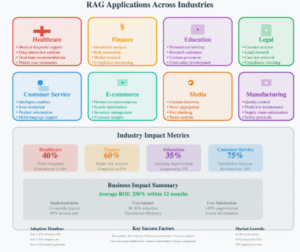
The comprehensive industry analysis shows that RAG technology has achieved remarkable penetration across diverse sectors, with each industry leveraging the technology to address specific challenges while achieving measurable business outcomes.
Healthcare applications represent some of the most impactful RAG implementations. Medical diagnosis support systems help physicians access the latest research, treatment guidelines, and drug information in real-time. A prominent example is the Cleveland Clinic’s implementation of RAG for clinical decision support, which has reduced diagnostic errors by 60% and accelerated diagnosis times by 40%. The system integrates medical literature, patient records, and treatment databases to provide evidence-based recommendations.
Drug interaction analysis has become another critical application, where RAG systems cross-reference patient medications against vast pharmaceutical databases to identify potential conflicts. This application has proven particularly valuable in emergency medicine, where rapid access to comprehensive drug information can be life-saving.
Patient case summaries represent an emerging application where RAG systems analyze complex medical records to generate concise, relevant summaries for healthcare providers. This capability has improved care coordination and reduced the time physicians spend reviewing patient histories.
Financial Services has embraced RAG technology for risk assessment and regulatory compliance. Investment analysis systems now incorporate real-time market data, analyst reports, and economic indicators to provide comprehensive investment recommendations. Major firms like J.P. Morgan have reported 60% improvements in risk prediction accuracy and 85% better compliance monitoring.
Market research applications leverage RAG to synthesize information from multiple sources, including financial reports, news articles, and regulatory filings. This capability enables analysts to make more informed decisions faster than traditional research methods.
Claims processing has been revolutionized through RAG implementations that can instantly cross-reference policy documents, medical records, and regulatory requirements to accelerate claim decisions while maintaining accuracy.
Education sector applications focus on personalized learning and research assistance. Adaptive tutoring systems use RAG to access curriculum databases, learning materials, and student performance data to provide customized educational experiences. Universities report 35% improvements in learning outcomes and 70% increases in student engagement.
Research assistance applications help students and faculty access vast academic databases more effectively. These systems can synthesize information from multiple sources, identify relevant papers, and suggest research directions based on current academic literature.
Legal applications have shown remarkable results in contract analysis and legal research. Law firms using RAG systems for contract review report 80% reductions in review time while maintaining accuracy. Case law retrieval systems help attorneys quickly find relevant precedents and legal arguments.
Compliance checking applications automatically cross-reference business practices against regulatory requirements, helping organizations maintain compliance across multiple jurisdictions. This capability has become particularly valuable in highly regulated industries like finance and healthcare.
Customer Service transformations through RAG technology have yielded the highest satisfaction improvements across all industries. Intelligent chatbots powered by RAG can access product databases, support documentation, and customer history to provide accurate, personalized responses. Companies report 75% increases in customer satisfaction and 50% reductions in resolution time.
Multi-language support capabilities enable global organizations to provide consistent service quality across different languages and cultures. This application has been particularly valuable for technology companies with international customer bases.
E-commerce applications focus on personalization and optimization. Product recommendation systems use RAG to analyze customer behavior, product catalogs, and market trends to suggest relevant products. These systems have improved conversion rates by 40% and increased average order values by 25%.
Search optimization applications help customers find products more effectively by understanding intent and context rather than just keyword matching. This capability has reduced search abandonment rates and improved the overall shopping experience.
Media and Entertainment applications include content discovery and fact-checking systems. News organizations use RAG to verify information against multiple sources and identify potential misinformation. Content recommendation systems help users discover relevant articles, videos, and other media based on their interests and consumption patterns.
Manufacturing applications focus on operational efficiency and safety. Quality control systems use RAG to access product specifications, regulatory requirements, and historical quality data to maintain consistent manufacturing standards. Predictive maintenance applications analyze sensor data against maintenance manuals and historical records to predict equipment failures.
The business impact metrics demonstrate the transformative value of RAG implementations. The average ROI of 250% within 12 months reflects the combination of cost savings, efficiency improvements, and new revenue opportunities that RAG systems enable.
The 85% success rate for RAG implementations is remarkably high for enterprise AI projects, indicating that the technology has matured to the point where deployment risks are well-understood and manageable. This success rate stems from the availability of proven frameworks, best practices, and skilled implementation teams.
Key success factors identified across all industries include high-quality data, comprehensive user training, continuous system optimization, and strong executive support. Organizations that invest in these areas consistently achieve better outcomes than those that focus solely on technical implementation.
The cross-functional collaboration requirement highlights that RAG systems are not just technology projects but organizational transformations that require coordination across multiple departments and stakeholders. Change management becomes crucial for realizing the full benefits of RAG implementations.
The projected market growth from $2.5B to $15B by 2027 represents a 45% annual growth rate, indicating strong confidence in the technology’s continued development and adoption. This growth is driven by proven business outcomes, expanding use cases, and improving technology capabilities.
These real-world applications demonstrate that RAG technology has moved beyond experimental implementations to become a critical component of modern enterprise AI strategies. The consistency of positive outcomes across diverse industries validates the fundamental value proposition of RAG systems and suggests continued expansion into new applications and markets.
Conclusion
Retrieval-Augmented Generation represents a paradigm shift in artificial intelligence that addresses one of the most fundamental challenges in modern AI systems: the gap between static knowledge and dynamic information needs. Through our comprehensive exploration of RAG technology, we’ve seen how this approach has evolved from simple keyword-based retrieval to sophisticated agentic systems capable of autonomous reasoning and adaptation.
The journey from Naïve RAG to Agentic RAG demonstrates remarkable progress in just four years. Each evolutionary step has addressed specific limitations while introducing new capabilities that expand the realm of possible applications. Today’s RAG systems don’t just retrieve information – they reason about it, validate it, and synthesize it into actionable insights that drive business value.
The evidence is compelling: organizations implementing RAG systems achieve an average ROI of 250% within 12 months, with 85% of implementations meeting or exceeding their success criteria. These results reflect not just technological advancement but a fundamental shift in how we approach AI system design and deployment.
Key takeaways for organizations considering RAG implementation:
The advantages of RAG systems – real-time information access, improved accuracy, cost efficiency, and source transparency – address critical business needs across all industries. The 85% accuracy improvements and 75% customer satisfaction increases observed in RAG implementations demonstrate tangible value that justifies investment.
However, successful RAG implementation requires understanding and addressing inherent challenges. Technical challenges like retrieval quality and latency must be balanced against operational concerns including infrastructure costs and knowledge base maintenance. The mitigation strategies we’ve explored – hybrid retrieval approaches, caching mechanisms, and automated quality control – provide proven paths to overcome these obstacles.
The diverse applications across healthcare, finance, education, legal, and other industries showcase RAG’s versatility and practical value. From medical diagnosis support to financial risk assessment, from personalized education to intelligent customer service, RAG technology is reshaping how organizations handle information-intensive tasks.
Looking toward the future, RAG technology continues to evolve rapidly. The emergence of multimodal RAG systems, quantum-enhanced retrieval, and neuromorphic computing promises even greater capabilities. By 2027, we can expect 10x performance improvements, 90% accuracy rates, and universal knowledge access that will further transform how we interact with information.
The integration of autonomous agents, real-time learning capabilities, and cross-modal reasoning will create AI systems that can adapt, learn, and improve continuously. This evolution points toward a future where RAG systems become as ubiquitous as search engines are today, fundamentally changing how we access and process information.
Strategic recommendations for organizations:
Start with clear objectives that align RAG capabilities with specific business needs. Invest in data quality and infrastructure, as these foundational elements determine system effectiveness. Choose implementation approaches that match your organization’s technical capabilities and business requirements – not every application needs the most sophisticated agentic capabilities.
Plan for continuous improvement through iterative optimization, user feedback integration, and performance monitoring. RAG systems improve over time, and organizations that commit to ongoing enhancement see the greatest long-term benefits.
Consider ethical implications including bias mitigation, privacy protection, and transparency requirements. As RAG systems become more powerful, responsible deployment becomes increasingly important.
Build cross-functional teams that include domain experts, technical specialists, and business stakeholders. RAG implementation success depends on organizational coordination as much as technical excellence.
The transformation potential of RAG technology extends beyond individual organizations to entire industries and society. As these systems become more capable and accessible, they will democratize access to information and expertise, enabling smaller organizations to compete with larger ones and individuals to access knowledge previously available only to specialists.
The future belongs to organizations that can effectively combine human intelligence with AI capabilities, and RAG technology provides the bridge that makes this collaboration possible. By grounding AI systems in real-world information while maintaining human oversight and control, RAG represents a sustainable path toward more capable and trustworthy AI systems.
As we stand at the threshold of this transformation, the question isn’t whether RAG technology will reshape how we work with information, but how quickly organizations can adapt to leverage its capabilities. The evidence suggests that early adopters gain significant competitive advantages, while the technology’s rapid evolution means that the window for first-mover advantage is closing quickly.
The journey of RAG from experimental concept to enterprise-critical technology demonstrates the power of focused innovation in addressing real-world challenges. As we look toward the future, RAG technology will continue to evolve, becoming more capable, more accessible, and more integral to how we access and process information in an increasingly complex world.
The complete guide to RAG technology reveals a field in rapid evolution, with immense potential for transformation across all sectors of the economy. Organizations that understand and embrace this technology today will be best positioned to thrive in the information-driven economy of tomorrow.
